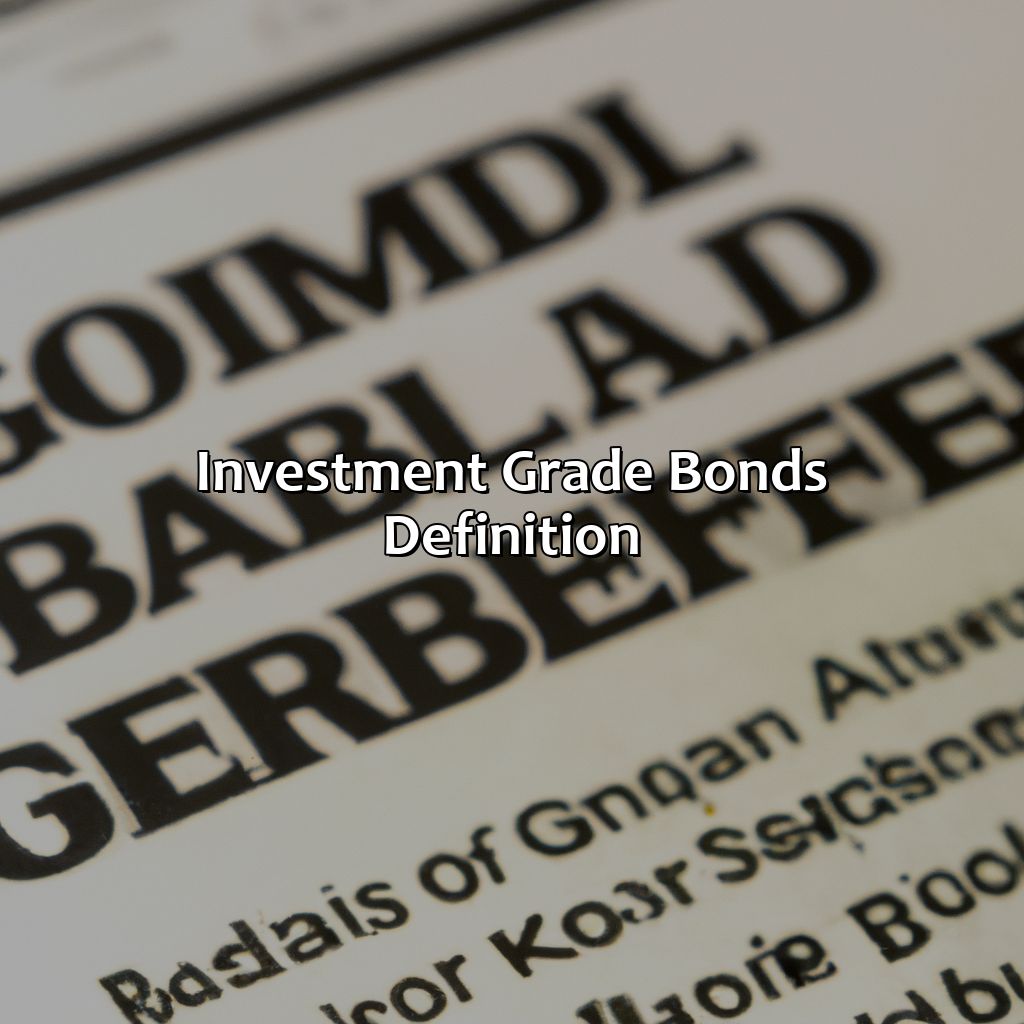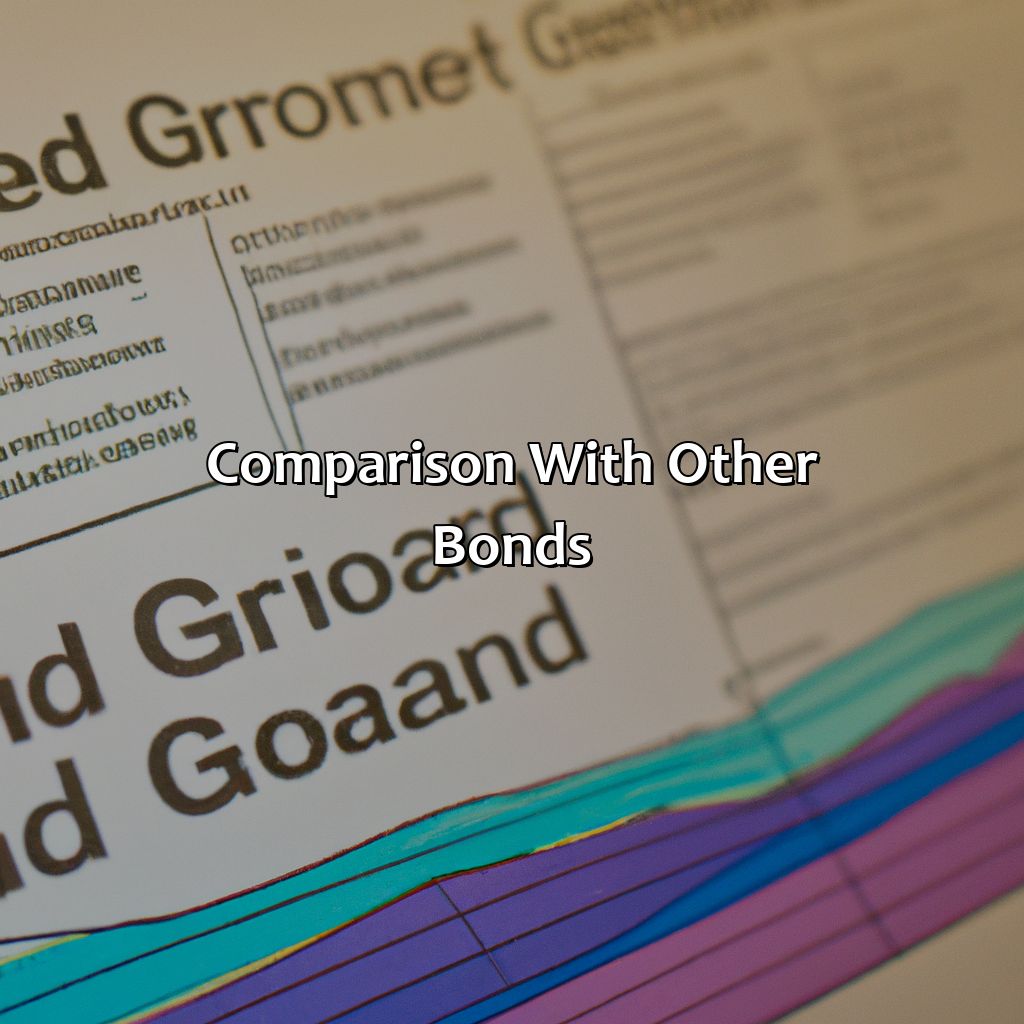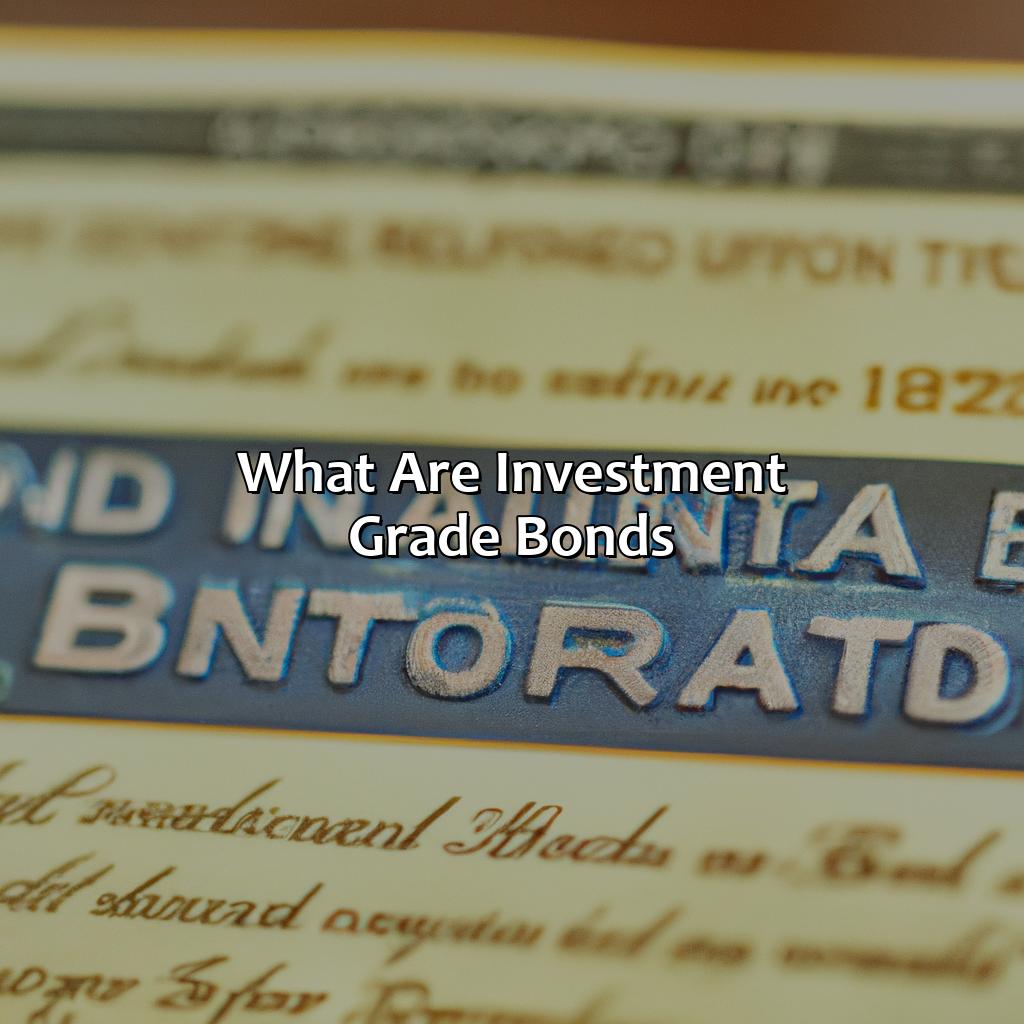What Are Investment Grade Bonds?
Key Takeaway:
- Investment grade bonds are bonds that are issued by companies or governments that are considered to have a low risk of default, as determined by credit rating agencies. These bonds are generally considered to be a safer investment than high-yield or junk bonds, but may offer lower returns.
- The benefits of investment grade bonds include lower default risk and the potential for steady returns. These bonds are generally considered to be a stable and secure investment option for those looking for a lower-risk option.
- However, investment grade bonds also come with risks, such as lower yields and interest rate risk. Investors should carefully consider these risks before investing in these bonds and may want to diversify their portfolio with other types of bonds or investments.
Are you wondering whether investing in bonds is a good option? Investment grade bonds are one of the safest and most profitable investments in today’s financial market. Discover how these bonds can provide you with long-term security and financial gain.
Investment Grade Bonds Definition
Gain insight into Investment Grade Bonds! Learn its definition and peek at Credit Ratings. Get a clear understanding by exploring two sub-sections:
- Define Investment Grade Bonds
- Examine its Credit Ratings

Image credits: retiregenz.com by David Duncun
What are Investment Grade Bonds?
Investment grade bonds are debt securities issued by corporations and governments with a higher credit rating. These Bonds have significantly lower default risk compared to lower-rated or unrated bonds, resulting in lower yields. Investment grade Bonds are suitable for investors looking for stable income streams with low risk as there is a low chance of losing principal.
Investment Grade Bonds provide ongoing and predictable returns through fixed-income streams without any worries of fluctuations or risks. Such bonds are divided into different quality levels from AAA to BBB-. Ratings reflect the likelihood of default and offer a convenient way to evaluate the financial stability of companies issuing investment-grade bonds. These Bonds are famous among institutional investors who tend to hold them over long-term periods.
Investors may benefit from using investment grade bond exchange-traded funds (ETFs) or mutual funds for diversified exposure to this broad category. However, investors need to consider the fees charged by these vehicles as they can significantly affect overall returns. In addition, it is suggested that an investor should research the underlying securities within these ETFs before investing as some may include lower-grade bonds alongside high-quality investment bonds.
Overall, investment-grade bonds provide investors with greater security as compared to high-yield corporate bonds and equities while providing predictable income streams that help preserve capital over long-term periods.
Credit ratings: the difference between being financially stable and just pretending like you are.
Credit Ratings
Credit ratings reflect the creditworthiness of bonds and other financial instruments. These ratings are assigned by credit rating agencies based on the issuer’s ability to repay the debt. The rating is typically denoted by a letter grade that ranges from AAA (highest) to D (default).
Investment-grade bonds have a rating of BBB- or higher, indicating a lower probability of default. They offer lower yields compared to high yield or junk bonds but provide stability and safety for investors.
Investment-grade bonds are typically issued by blue-chip companies with a long history of stable earnings, low debt levels, and strong financials. These bonds are less risky and provide consistent income streams for investors. In contrast, non-investment grade bonds (also known as sub-investment grade or high yield) carry higher risks but offer higher yields to compensate for that risk.
Investment-grade bonds enjoy a high level of demand from institutional investors such as pension funds, insurance companies, and mutual funds. Since these investors typically have strict investment guidelines that require them to invest only in safe and low-risk assets, investment-grade bonds fit well within their portfolios.
Investors looking for stability and security in their investments should consider including investment-grade bonds in their portfolio. With lower default risks, higher liquidity, and consistent income streams, these bonds can provide an attractive risk-reward profile for investors seeking steady returns over the long term.
Investment grade bonds are like the dependable friend who always shows up to your party, except they bring steady returns instead of a six-pack.
Benefits of Investment Grade Bonds
Investment grade bonds offer a lower default risk and security. Therefore, it’s wise to choose them to reduce the chance of losing money. Plus, they produce steady returns. These can be divided into lower default risk and security sub-sections.

Image credits: retiregenz.com by David Duncun
Lower Default Risk
One of the key advantages of investment grade bonds lies in their overall lower risk of default. Investment grade bonds are issued by companies or governments with a strong financial track record, making them less likely to default on their payments. This makes them a safer investment option for those seeking stability and consistency in their portfolios.
Investors who prioritize low default risk often turn to investment grade bonds as a means of securing steady income streams over time. While such bonds may offer lower yields than riskier options, they also offer more predictable returns and fewer negative surprises. Moreover, investment grade bonds tend to display less price volatility and tend to hold up better during market downturns which offers an additional layer of protection against losses.
It is worth noting that not all investment grade bonds are created equal, with some issuers being seen as more reliable than others due to factors such as credit rating and industry-specific risks. In addition, market conditions can also play a role in determining the level of perceived risk associated with investment grade bonds at any given time.
Historically speaking, investors have turned to investment grade bonds during times of economic uncertainty or heightened risk aversion. For example, following the 2008 financial crisis many investors shifted away from stocks and towards the relative safety and security offered by high-quality corporate and government-issued debt securities. While there are always exceptions to the rule, it is generally true that investment grade bond investments offer lower default risk compared to other types of financial instruments which makes them a favorable choice for investors looking for stability in their portfolio.
Security and steady returns – like a trusty ex, investment grade bonds may not give you butterflies anymore, but they’ll always be there for you when you need them.
Security and Steady Returns
Investment grade bonds provide an excellent opportunity for investors seeking security and consistent returns. These bonds have a higher credit rating, indicating lower default risk, making them a safer investment than their less secure counterparts. With steady returns, investors can count on reliable income without the ups and downs of the market.
These bonds have a proven track record of maintaining stability during economic downturns, preserving capital in turbulent times. Unlike other investments, they offer both safety and liquidity as they can be easily bought or sold in the secondary market. This makes them an ideal choice for risk-averse investors looking for long-term gains.
In addition to this, investment grade bonds are often issued by established companies with a strong financial standing who can honor the coupon payments to investors on time. Furthermore, these securities are exempted from federal taxes and are often considered as an alternative to equity investments.
A wise investor’s decision to invest in investment grade bonds turned out fruitful when the 2008 recession hit. A woman invested most of her retirement savings into such securities after listening to the advice of her Investment Advisor. During the recession times, her investment not only survived but provided her with enough income to meet her daily needs while keeping her principal amount safe.
Remember, investment grade bonds may be safe, but they’re not exactly a thrill-a-minute ride – kind of like the Disneyland It’s a Small World ride, but with less chance of getting stuck in a creepy animatronic boat.
Risks of Investment Grade Bonds
Grasping the dangers of investment grade bonds with smaller yields and interest rate risk requires investigation. Investment grade bonds present lower yields compared to high yield bonds, but come with their own set of risks. Knowing these risks, such as interest rate risk, is an essential part of making intelligent investment choices.

Image credits: retiregenz.com by Joel Jones
Lower Yields
Investment grade bonds have lower returns compared to their high-yield counterparts. These bonds do not offer attractive yields, but they are considered to be less risky investments due to the stable financial situations of the issuer companies. Therefore, investors looking for lower-risk investment options may prefer investment grade bonds.
The low yields of investment grade bonds can be attributed to the fact that companies with a good credit rating do not need to pay high interest rates to attract investors. Instead, they issue low-interest debt securities and still manage to find plenty of buyers since safety is a significant concern for many investors.
Additionally, investment-grade bonds are relatively liquid products; hence an investor can sell it at any time without facing any setbacks. However, these bonds are usually bought by larger institutional entities in large volumes due to low-interest rates.
Investors should be aware that while these types of bonds offer stability and predictable income generation, the return offered is often lower than other forms of investment which might counteract inflation.
Overall, potential investors must understand that lesser yields from investment-grade bonds come with increased safety precautions – which if looked at differently will curb loss during market downturns or difficulties.
Interest rate risk is like a bad tinder date, you never know when the rate will suddenly change and leave you high and dry.
Interest Rate Risk
Regarding the potential risks of investment grade bonds, one of the factors that can significantly impact your investments is known as Rate Fluctuation Risk. The interest rate risk is an elemental aspect to consider in the bond markets since it refers to the possibility of losing money if interest rates increase or decrease contradicting market expectations.
Investors who choose long-term fixed-rate bonds are more vulnerable to interest rate risks than those choosing short-term bonds. Additionally, changes in the overall economic climate could help determine whether it is an appropriate moment to buy or sell investment grade bonds.
It is important to note that special indicators must be considered when assessing these types of risks such as yield curve analysis and duration estimations for predicting possible fluctuations in interest rates due to political or economic policies.
To minimize interest rate risks concerning fixed-income securities, investors may try strategies such as Immunization and Ladder approaches. These methods’ primary objective is, respectively, neutralizing negative impacts generally caused by changes in bond prices due to external factors and fragmenting investments over different maturities.
Investment grade bonds may be safe compared to other bonds, but it’s like being the slowest gazelle in the savannah – you’re still at risk of being caught by the lion.
Comparison with other Bonds
Investment grade bonds differ from other bond types, such as High-Yield and Treasury Bonds. We’ll look at these two bonds separately. High-Yield/Junk Bonds and Treasury Bonds have different levels of risk, credit ratings and potential returns.

Image credits: retiregenz.com by David Washington
High-Yield/Junk Bonds
High-Yield or Junk bonds are high-risk securities that offer a higher yield than investment grade bonds. Issued by companies with poor credit ratings, they have a higher default risk compared to investment grade bonds and may not be suitable for conservative investors.
Investors who want to brave the risks and invest in High-Yield Bonds should be guided by an experienced professional, given the complex liquidity considerations involved in such investments. The lower credit quality of these securities means that their prices fluctuate more than other bonds. However, when selected properly, they may provide attractive returns and diversification benefits in a portfolio.
It is essential to note that investing too heavily into high-yield bonds can potentially lead to substantial losses. These types of bonds typically require diligent risk management but can offer potential diversification benefits, as well as improved returns when approached tactically.
Pro Tip: Consider allocating just a small percentage of your portfolio to high-yield/junk bonds. Keep yourself updated about their market trends and invest wisely.
When it comes to Treasury Bonds, the only thing riskier than investing is trying to explain to your grandma what a bond even is.
Treasury Bonds
One form of high-grade bonds issued by the federal government that has attracted many investors are securities, also known as ‘government bonds’. These bonds are financial instruments widely considered to be among the safest investments and are low-risk options for those looking for security. Investors can invest in 3-month, 6-month, 2-year, or even 30-year treasury bonds with interest rates determined by prevailing market conditions.
Investing in treasury bonds provides a guaranteed return on investment as they have a low default risk associated with them. In addition, these bonds offer stable returns over long periods, making them ideal for conservative investors. The security of these investments is especially important when weighed against short-term fluctuations in stock or bond prices.
What sets treasury bonds apart from other types of government-issued securities is that they can only be bought and sold on public exchanges – you won’t find them among any stored investments like institutional products or mutual funds.
For those looking to make more significant gains over time while still keeping their portfolios balanced and diversified, there may be other strategies to consider in conjunction with investing in treasury bonds within fixed-income portfolios. Diversification between different asset classes and sectors is key to maximizing portfolio stability. For riskier investors who value high yield potential over security, it might make sense to consider investment options like emerging market debt or high-yield corporate bonds while retaining a smaller allocation of US Treasury notes in their portfolio.
It’s no news that investing in the wrong type of vehicles can lead to loss; therefore investors need to assess their personal objectives before committing money into any type of investment vehicle. Consultation with a licensed financial advisor will help advise on tailored recommendations suitable for different investor needs while evaluating financial objectives like risk tolerance and income expectations.
Some Facts About Investment Grade Bonds:
- ✅ Investment grade bonds are bonds that are given a high credit rating by credit rating agencies, indicating a low risk of default. (Source: Investopedia)
- ✅ Investment grade bonds are typically issued by companies, governments, and municipalities seeking to raise capital. (Source: The Balance)
- ✅ Bonds with an investment grade rating are generally considered less risky than bonds with a lower credit rating, but they may offer lower returns. (Source: Schwab)
- ✅ The three major credit rating agencies, Standard & Poor’s, Moody’s, and Fitch, assign credit ratings to investment grade bonds based on factors like the issuer’s financial health and the bond’s terms. (Source: Forbes)
- ✅ Some examples of investment grade bonds include U.S. Treasury bonds, corporate bonds from large companies like Microsoft, and municipal bonds from cities like New York or Chicago. (Source: CNN Business)
FAQs about What Are Investment Grade Bonds?
What are investment grade bonds?
Investment grade bonds are bonds that are issued by corporations or governments with a credit rating of BBB- or higher. They are considered to be the safest bonds because they have a lower risk of defaulting.
What is the difference between investment grade bonds and high-yield bonds?
Investment grade bonds have a lower risk of defaulting and offer lower interest rates compared to high-yield bonds, which are also called junk bonds. High-yield bonds are issued by companies or governments with a lower credit rating and higher risk of defaulting.
Who should invest in investment grade bonds?
Investment grade bonds are suitable for investors who are looking for a low-risk investment option that offers regular income. They are a good choice for retirees, who want to preserve their capital and earn regular income without taking on too much risk.
What are the advantages of investing in investment grade bonds?
Investment grade bonds offer several advantages, including lower credit risk, steady income, and diversification. They are a good way to balance out a portfolio that is heavily invested in stocks or other high-risk assets.
What are the disadvantages of investing in investment grade bonds?
The main disadvantage of investing in investment grade bonds is that they offer lower returns compared to other asset classes such as stocks or high-yield bonds. They are also sensitive to interest rate changes and can lose value if interest rates rise.
How can I invest in investment grade bonds?
There are several ways to invest in investment grade bonds, including buying individual bonds, investing in bond funds, or buying ETFs that track a bond index. The best option depends on your investment goals, risk tolerance, and financial situation.
